The AMD Zen and Ryzen 7 Review: A Deep Dive on 1800X, 1700X and 1700
by Ian Cutress on March 2, 2017 9:00 AM ESTBenchmarking Performance: CPU Rendering Tests
Rendering tests are a long-time favorite of reviewers and benchmarkers, as the code used by rendering packages is usually highly optimized to squeeze every little bit of performance out. Sometimes rendering programs end up being heavily memory dependent as well - when you have that many threads flying about with a ton of data, having low latency memory can be key to everything. Here we take a few of the usual rendering packages under Windows 10, as well as a few new interesting benchmarks.
Corona 1.3
Corona is a standalone package designed to assist software like 3ds Max and Maya with photorealism via ray tracing. It's simple - shoot rays, get pixels. OK, it's more complicated than that, but the benchmark renders a fixed scene six times and offers results in terms of time and rays per second. The official benchmark tables list user submitted results in terms of time, however I feel rays per second is a better metric (in general, scores where higher is better seem to be easier to explain anyway). Corona likes to pile on the threads, so the results end up being very staggered based on thread count.
Blender 2.78
For a render that has been around for what seems like ages, Blender is still a highly popular tool. We managed to wrap up a standard workload into the February 5 nightly build of Blender and measure the time it takes to render the first frame of the scene. Being one of the bigger open source tools out there, it means both AMD and Intel work actively to help improve the codebase, for better or for worse on their own/each other's microarchitecture.
LuxMark
As a synthetic, LuxMark might come across as somewhat arbitrary as a renderer, given that it's mainly used to test GPUs, but it does offer both an OpenCL and a standard C++ mode. In this instance, aside from seeing the comparison in each coding mode for cores and IPC, we also get to see the difference in performance moving from a C++ based code-stack to an OpenCL one with a CPU as the main host.
POV-Ray 3.7
Another regular benchmark in most suites, POV-Ray is another ray-tracer but has been around for many years. It just so happens that during the run up to AMD's Ryzen launch, the code base started to get active again with developers making changes to the code and pushing out updates. Our version and benchmarking started just before that was happening, but given time we will see where the POV-Ray code ends up and adjust in due course.
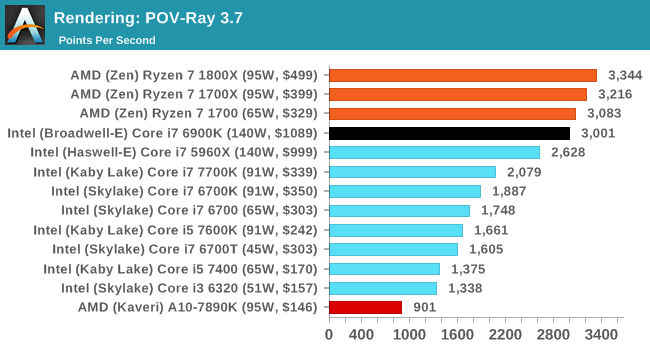
Cinebench R15
The latest version of CineBench has also become one of those 'used everywhere' benchmarks, particularly as an indicator of single thread performance. High IPC and high frequency gives performance in ST, whereas having good scaling and many cores is where the MT test wins out.

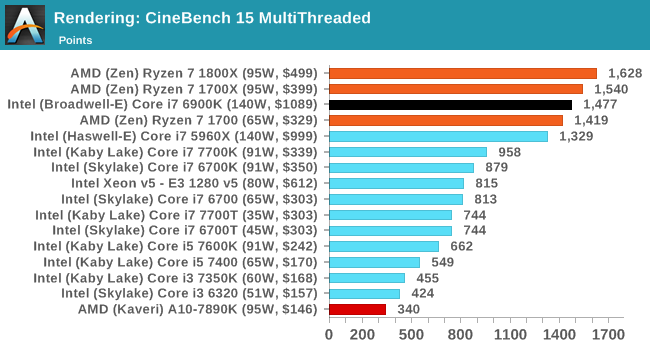


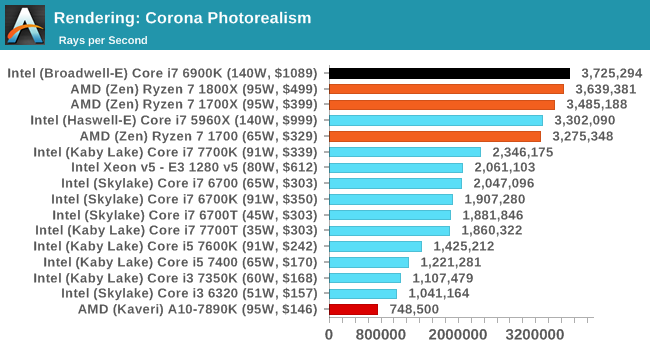
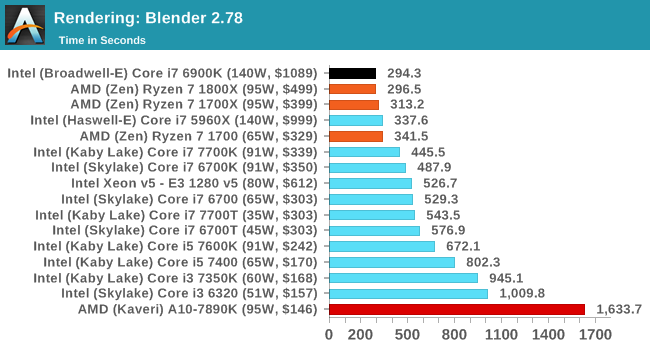

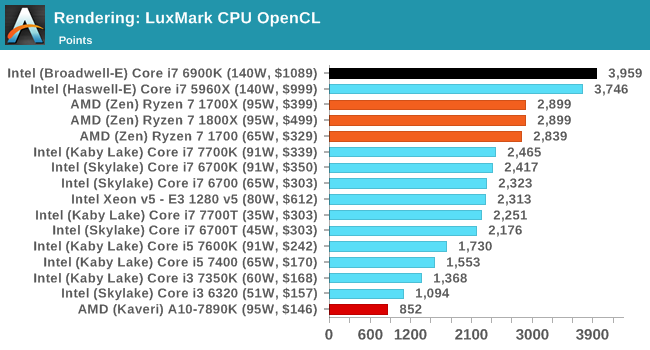








574 Comments
View All Comments
Crono - Thursday, March 2, 2017 - link
A Hero Has RyzenSweeprshill - Thursday, March 2, 2017 - link
Lived up to the hype. Ryzen is a beast. Intel needs massive price cuts on their 2011-v3 chips. Well done AMD, best price/performance CPUs on the market and as fast or faster than Intel performance.sans - Thursday, March 2, 2017 - link
Hey, what you have found which features improving on AMD's crap has been found in Intel's products for years.Nem35 - Thursday, March 2, 2017 - link
Yeah, and it's beating the Intel. Funny, right?Sweeprshill - Thursday, March 2, 2017 - link
Yeah these new AMD chips are monsters. Wondering how large the price cuts are that Intel will bring to their 2011-v3 chips to compete.czerro - Friday, March 3, 2017 - link
Intel already slashed prices pretty drastically 4 days ago, to kinda deflate Ryzen's release. Before price cuts, Ryzen had a huge price and performance advantage at all metrics, and Intel would have looked ridiculous.I can't believe people aren't reporting the price-cutting right before Ryzen release more. Intel only did it to save face on graphs and confuse people. Ryzen definitely had Intel by the balls a week ago before the price cuts.
It's great that we all have options now, but this really smeared Ryzen's release in a cheap way that anybody can point out all those Intel chips were 100-200 dollars more expensive less than a WEEK ago.
SodaAnt - Saturday, March 4, 2017 - link
No, Intel hasn't slashed prices. There was a sale at microcenter a few days back, but there's no across the board official price cut on Intel chips.Notmyusualid - Monday, March 6, 2017 - link
@ SodaAntAgreed, I see no Intel price drops either.
Notmyusualid - Friday, March 3, 2017 - link
@ Nem35Incomplete review.
After seeing a gaming-focused review, I'd say the AMD procs are just OK. I welcome AMD is back with a fighting chance, but about half my purchase choice will be game-inspired.
Quote:
"For gaming, it’s a hard pass. We absolutely do not recommend the 1800X for gaming-focused users or builds, given i5-level performance at two times the price."
I'm not a 'fanboi', as I'd have no trouble fitting a 1700X in a build I wouldn't game in. But otherwise, like another reviewer said, its a hard pass.
Alexvrb - Saturday, March 4, 2017 - link
For gaming builds the upcoming Ryzen 5 and 3 series will offer a lot more bang for your buck and will compete much more aggressively. However, the Ryzen 7 still offers decent gaming performance and excellent performance everywhere else. The gobs of cores may come in handy in the future too, even in games - as more threads will be available on more rigs, devs will take notice. This year AMD is definitely lowering the pricing for 8-16 thread processors, clearing a path for the future of gaming.With that being said I still think that when strictly considering gaming, their Ryzen 3/5 quadcore models will be a far better value, especially as current-gen games aren't often built in such a way that they can take advantage of the Ryzen 7.